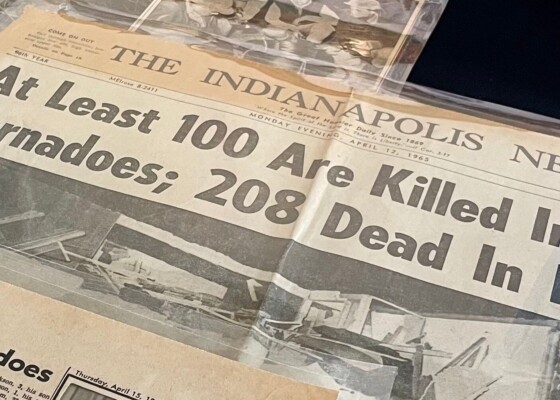The Eerie Explorations of Mary Shelley & Ray Bradbury
April 9, 2018One of the best aspects of One State/One Story: Frankenstein are the many surprising Hoosier connections to Mary Shelley’s remarkable novel, including the humanities scholars who can give us fresh…
One of the best aspects of One State/One Story: Frankenstein are the many surprising Hoosier connections to Mary Shelley’s remarkable novel, including the humanities scholars who can give us fresh insight and help us consider the timeless questions about science and what it means to be human at the heart of the novel.
That’s just what we did during a recent talk at Ivy Tech Central in Indianapolis. The talk, “Mary Shelley’s November Is Ray Bradbury’s October: The Supernatural Fiction of Ray Bradbury,” was given by Dr. Jonathan Eller, Chancellor’s Professor of English and director of the Center for Ray Bradbury Studies at IUPUI on Monday, March 26.
The title for Eller’s talk cleverly references the opening of chapter four in Frankenstein, the famous passage recalling the night Victor’s creature comes to life:
It was on a dreary night of November that I beheld the accomplishment of my toils. With an anxiety that almost amounted to agony, I collected the instruments of life around me, that I might infuse a spark of being into the lifeless thing that lay at my feet. It was already one in the morning; the rain pattered dismally against the panes, and my candle was nearly burnt out, when, by the glimmer of the half-extinguished light, I saw the dull yellow eye of the creature open; it breathed hard, and a convulsive motion agitated its limbs.
Eller playfully tied Shelley’s reference to November to Ray Bradbury’s The October Country, a collection of short stories published in 1955. As Eller noted, both writers were drawn to the eerie to explore big picture questions about what makes us human. Eller elaborated on these questions, identifying five nexus points of connection between Shelley’s and Bradbury’s works. For each of these questions, he also pointed to a short story or novel in which “the October Man” wrestled with these themes. Read ahead to learn about commonalities between these two masters of speculative fiction.
- Can the ‘created’ replicate the creator? Bradbury considers this question in “Blade of Grass,” which was first published in Thrilling Wonder Stories (December 1949). It can be found in Bradbury Stories: 100 of His Most Celebrated Tales (2005).
- Can a replicant replace a living being? This question is at the heart of “The Long Years.” Most know the story from The Martian Chronicles, but it was first published in Maclean’s (September 1948) as “Dwellers in Science.
- Can a replicant share intimacy? Bradbury explored this provocative idea in “Changeling,” first published in Super Science Stories (July 1949). Now you can read it in Bradbury Stories: 100 of His Most Celebrated Tales (2005).
- Can the creator justifiably destroy the creation? Spoiler alert: this question tortures Victor! Read what Bradbury had to say in “Punishment without Crime,” first published in Other Worlds (March 1950). It’s also in The Stories of Ray Bradbury (2010).
- Can the ‘created’ become a destroyer? Bradbury examines the possibilities in “Purpose,” first published in Startling Stories (July 1950) and later as “The City” in the short story collection The Illustrated Man (1951, 2012) and The Stories of Ray Bradbury (2010).
Eller said that “the heart is a gateway to our humanity.” As writers and creatives, Shelley and Bradbury each understood that the key to what makes us human isn’t to be found in the domain of science. It is art that helps us to make sense of our humanity. This year, as part of One State/One Story, we’re asking: How has Frankenstein helped you explore what it means to be human? Let us know in the comments below.
If you would like to learn more about Bradbury, check out Eller’s biographical works Becoming Ray Bradbury and Ray Bradbury Unbound. You can visit the Center for Ray Bradbury Studies at IUPUI to tour the author’s recreated office and see many of his personal artifacts and papers. It’s an Indianapolis treasure trove!
This blog post was written by Jessie Cortesi, Public History Intern at Indiana Humanities.
One State / One Story: Frankenstein is an Indiana Humanities program and has been made possible in part by a major grant from the National Endowment for the Humanities and in partnership with the Indiana State Library and Indiana Center for the Book. Any views, findings, conclusions, or recommendations expressed in this program do not necessarily represent those of the National Endowment for the Humanities.


